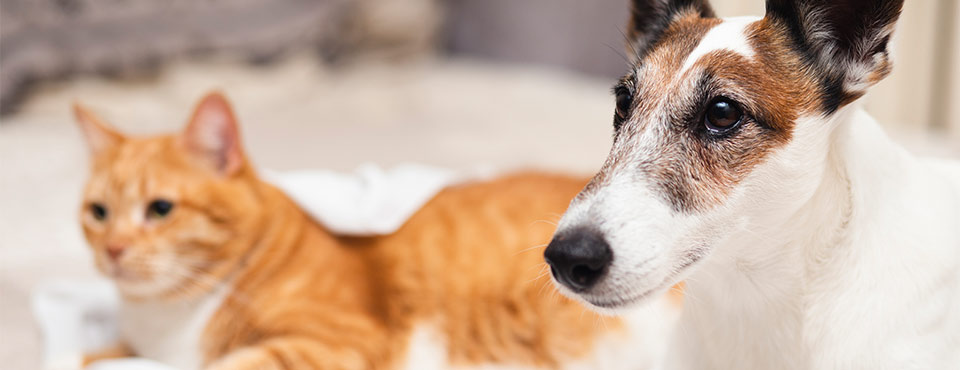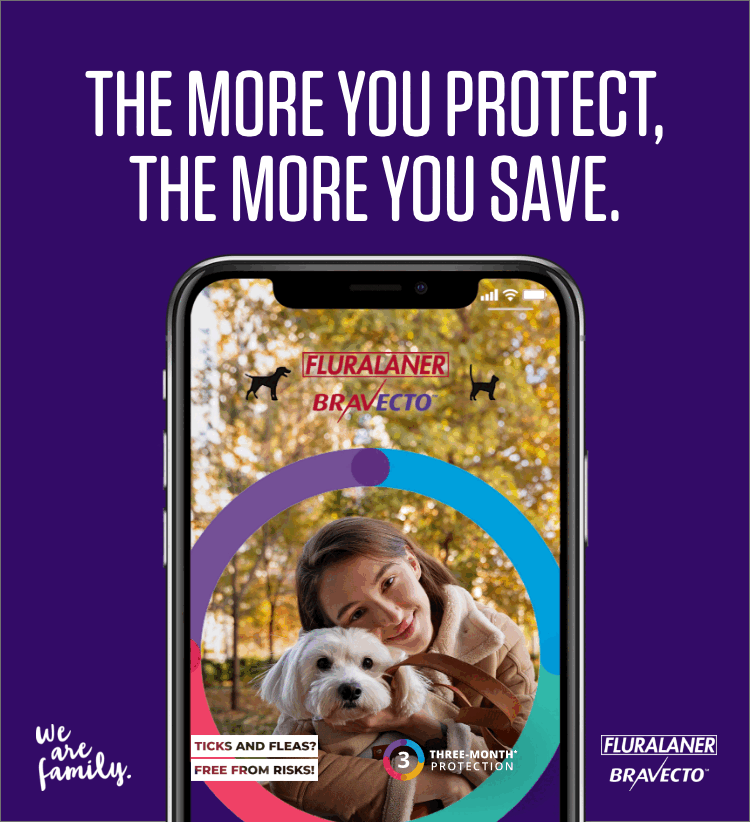Terms to learn when your dog or cat has Diabetes
HEALTH & PROTECTION
4 Oct, 2024
11 minutes

Finding out your dog or cat has diabetes can be a lot to digest. Your veterinarian will advise you about dietary changes, exercise and insulin treatment. You might need to monitor your pet’s water intake, eating habits, activity levels, and you could likely be responsible for administering insulin injections – all of which may seem like a lot at first! On top of all of this, there will likely be many new medical terms you’ll be hearing or reading which you may not be familiar with, but which you will want to know so that you can ask the right questions and stay on top of your pet’s needs.
With that being said, let’s take a look at a list of medical terms relevant to your diabetic dog or cat.
Acromegaly
Occurs due to excessive growth hormone production by the pituitary gland due to a benign pituitary tumor called an adenoma. The main signs include thickening of the skin, soft tissues, and bones of the head and feet. There is also high blood pressure (hypertension) and insulin resistance. Acromegaly is not uncommon in cats and may be present in some diabetic cats.

Beta cells
Beta cells are found in the pancreas that produce, store and release insulin.
Cataract
An opacity of the lens of one or typically both eyes. Cataracts are the most common complication of diabetes in dogs. Diabetic cataracts develop in dogs when blood glucose is high for a prolonged period (chronic hyperglycemia). Breakdown products of these high concentrations of glucose bind to proteins in the lens of the eye. This draws water into the lens of the eye, which swells disrupting its normal clear structure. These changes may not be visible immediately, but the lens of the eye gradually becomes opaque leading to partial or complete visual impairment. Your veterinarian can advise you about your dog’s cataracts and may recommend surgery. Cataract surgery may be carried out in dogs once the clinical signs of diabetes in your dog have improved or resolved on insulin treatment. Diabetic cataracts are not found in diabetic cats.
Complications
The good news is that diabetic dogs and cats develop fewer long-term complications than their human counterparts. Cataracts are a complication of diabetes in dogs and lead to reduced vision. Neuropathy is a complication of feline diabetes and leads to weak back legs. The presence of another disease or infection (such as infection and/or inflammation (gingivitis) of the gums) may make diabetes more difficult to manage. It is important that diabetics that suddenly have a recurrence or worsening of signs be checked for infections and other diseases. Signs that a diabetic dog or cat is not feeling well include poor appetite, lethargy and looking depressed. Diabetic cats that are not feeling well may not groom regularly and have a dry, dull or lusterless coat. Ketoacidosis, a potentially life-threatening condition with signs including decreased appetite, vomiting and lethargy, can develop in diabetics.
Diabetes mellitus
A condition where the pancreas does not produce any or enough insulin or the body is not able to use insulin effectively. The three most common types of diabetes are: type 1, type 2, and secondary diabetes.
Fructosamine
Fructosamines are formed when proteins (e.g. albumin in the blood) are glycosylated. Fructosamine concentration reflects the average glucose concentration over the previous few weeks. Fructosamine measurement may be used to assist in the diagnosis of diabetes mellitus, particularly in cats, and is sometimes used to monitor the effectiveness of insulin therapy.
Glucagon
A hormone produced by the pancreas. If blood glucose levels decrease, it triggers the body to release stored glucose into the blood stream.
Glucose
Also called blood sugar. The main sugar the body produces to store energy from proteins, fats and carbohydrates. Glucose is the major source of energy for living cells and is carried to each cell through the bloodstream. Cells cannot use glucose without the help of insulin.
Glucose curve
A series of measurements of blood glucose taken after insulin is administered over a number of hours to monitor the response to treatment.Glucose curves are sometimes used to help to assess whether a change in insulin dose is needed.
Glucose monitor
Continuous glucose monitors (CGM) are small electronic sensors designed for use in humans with diabetes but now commonly used in diabetic dogs and cats. These sensors are put into the skin and work for up to 14 days. They take small measurements of glucose concentration in tissue fluid. This is used to assess the response to treatment over a number of days.
Glycaemia
Blood glucose.
Glycogen
A form of glucose that is used for storing energy in the liver and muscles. If blood glucose levels decrease, the hormone glucagon triggers the body to convert glycogen to glucose and release it into the blood stream.
Glycosylation
The uncontrolled, non-enzymatic reaction of sugars with proteins. Very important in the complications of diabetes mellitus where abnormally high glucose levels result in the glycosylation of proteins such as in the lens of the eye (in dogs) leading to cataracts, or nerves (in cats) leading to peripheral neuropathy.
Glycosuria
Glucose in the urine.
Glucocorticoids
A type of hormone that is used in the treatment of allergy. Glucocorticoids work against the action of insulin and are a risk factor for diabetes, particularly in cats.
Hyperglycemia
A raised level of glucose in the blood. It occurs when the body does not have enough insulin or cannot use the insulin it does have to turn glucose into energy. Signs of hyperglycemia include excessive thirst and need to urinate often.
Hypoglycemia
A lowered level of glucose in the blood. This occurs when too much insulin has been injected, too little food has been eaten, or there has been too much exercise. Low blood glucose is not uncommon in diabetics on insulin. Diabetic dogs and cats may have few or no signs of low blood glucose. Any change in your pet’s behavior no matter how subtle could be important. Hypoglycemia can manifest as nervousness, tremors, weakness or persistent hunger. Low blood glucose can be serious or even life threatening and needs prompt attention. Contact your veterinarian if you think your diabetic dog or cat might be showing signs of hypoglycemia. If your pet is able to swallow, try feeding a little of your pet’s food. If your pet is not willing or able to eat, rub a small amount of a glucose source (such as corn syrup or glucose powder, tablets or gel) onto your pet’s gums. Administer glucose carefully – do not pour the solution into your pet’s mouth as this may choke your pet. Take care to avoid an accidental bite. You should see a response in 10-15 minutes.
Insulin
A hormone produced in the pancreas. If blood glucose levels increase, insulin triggers cells to take up glucose from the blood stream and convert it to energy, and the liver to take up glucose from the blood stream and store it as glycogen.
Ketoacidosis
Ketoacidosis in diabetics (diabetic ketoacidosis or DKA) is caused by a profound lack of insulin. This may happen because of illness or getting too little insulin. This may result in very high blood glucose concentrations which needs emergency treatment. The body starts using stored fat for energy, and ketone bodies (acids) build up in the blood. Signs of ketoacidosis can be subtle but if left unchecked this condition can be life threatening. In severe cases, the signs include vomiting, which can lead to loss of water from the body, stomach pain, deep and rapid breathing, a fruity breath odor, a rapid and weak pulse, and low blood pressure.
Ketone
A byproduct of fat metabolism. Excess ketones are found in the blood when the metabolism is very abnormal e.g. in diabetic ketoacidosis.
Ketonuria
Presence of ketones in the urine; an indication that there is diabetic ketoacidosis.
Neuropathy
Neuropathy results from the binding of sugar breakdown products to proteins in the nerves, leading to abnormal function. Neuropathy is a complication of feline diabetes and leads to weak back legs. Other causes of weak back legs in cats include arthritis. Neuropathy due to diabetes in cats may improve with additional care and attention.
Obesity
By definition, 20% or more extra body fat. Fat works against the action of insulin. Extra body fat is a risk factor for diabetes, particularly in cats.
Pancreas
An organ located behind the stomach. The pancreas produces several important hormones involved in digestion as well as hormones like insulin and glucagon that are involved in glucose regulation.
Pancreatitis
Pancreatitis is a condition where there is inflammation of the pancreas. Pancreatitis can be acute or chronic and may be present in diabetic dogs and cats. Acute pancreatitis can be a severe and life threatening with clinical signs including vomiting and a painful abdomen. Chronic pancreatitis may have subtle digestive signs and be recurrent in nature. The presence of pancreatitis can make diabetes difficult to manage.
Pen
A semi-automated device that contains insulin. Insulin pens were first designed for use in humans and make giving insulin injections easier. Insulin pens are available for use with human insulins and also with veterinary insulin. Particularly at the low doses required by cats and some dogs, insulin pens are more accurate than insulin syringes and may help to avoid hypoglycemia.

Polydipsia
Excessive thirst; a sign of uncontrolled diabetes.
Polyphagia
Excessive food intake; constant urge to eat.
Polyuria
Excessive urination; a sign of uncontrolled diabetes.
Rebound hyperglycemia
Rebound hyperglycemia or the Somogyi effect is hyperglycemia that occurs in response to hypoglycemia, leading to increases in the secretion of hormones that increase blood glucose (e.g., epinephrine, norepinephrine, glucagon, cortisol and growth hormone). This is seen in diabetic dogs and cats following administration of too much insulin. It is often misinterpreted as an insufficient response to insulin treatment. Blood glucose often fluctuates from high to low over a few days.
Remission
Remission is the resolution of signs of diabetes and is seen in some diabetic cats after a period of insulin treatment. Remission can be confirmed when the signs of diabetes remain absent for at least 4 weeks after insulin treatment has been stopped. Remission can occur when the pancreas has not fully lost the ability to produce insulin and recovers with insulin treatment. This appears to be related to previous treatment (glucocorticoids), loss of weight following diagnosis and duration of diabetes. Ask your veterinarian whether remission may be a treatment goal for your cat. Remission is seldom seen in diabetic dogs.
Renal threshold (glucose)
When the blood glucose (sugar) is so high that the kidneys are unable to reabsorb the excess and the substance appears in the urine.
Resistance
Insulin resistance is where the response to a given amount of insulin is lower than expected. This is what occurs in type 2 diabetics but also where hormones that counteract insulin (including glucocorticoids) are present. Diabetics with insulin resistance have high blood glucose but care is needed when increasing the insulin dose, as resolving the insulin resistance may cause hypoglycemia to occur.
Secondary diabetes
A less common type of diabetes, which arises as a complication of other diseases (e.g. hormone disturbances or diseases of the pancreas like pancreatitis).
Syringes
Insulin syringes are special syringes calibrated for use with insulin. The measurements on insulin syringes are in units – a special measurement used for insulin. There are two types of insulin syringe available – U40 for veterinary insulins and U100 for human insulins. It is very important that the correct type of insulin syringe is used for the insulin your animal is receiving. Insulin dosing errors from using the wrong syringe can cause serious issues including hypoglycemia.
Type 1 diabetes
Type 1 diabetes, or insulin-dependent diabetes, is the more common form of diabetes seen in dogs. Type 1 diabetes is an immune-mediated condition. In type 1 diabetes the pancreas is no longer able to produce insulin.
Type 2 diabetes
Type 2 diabetes, or non-insulin-dependent diabetes, is the more common form of diabetes seen in cats. Type 2 diabetes develops secondary to obesity and/or glucocorticoid treatment. In type 2 diabetes the pancreas is unable to produce enough insulin for the body’s needs.
Units
Insulin is measured in units rather than in grams or ounces. Units are a special measure that is related to the decreases in blood glucose produced by insulin under special testing conditions. There are two concentrations of insulin available – veterinary insulins contain 40 units per milliliter and human insulins contain 100 units per milliliter. The lower concertation of veterinary insulins is suited to accurate dosing of the smaller body size of diabetic dogs and cats compared to humans. It is very important that the correct type of insulin syringe is used for the insulin your animal is receiving. (see insulin syringes)
While this list may feel somewhat extensive, it is helpful to be familiar with these terms as you care for your diabetic dog or cat and begin to understand your pet’s condition. Being familiar with these various medical terms can be helpful to you in asking the right questions to your veterinarian and for being armed with knowledge as you embark on this healthcare journey with your furry companion.

RECOMMENDED
POPULAR PAGES
RELATED POSTS
-

Finding out your dog or cat has diabetes can be a lot to digest, learn all the terms so you can ask the right questions and stay on top of your pet’s needs.
-

Pets do not understand the holidays period which change their routines. Here are 6 tips to create a pet friendly home during Chrismas!
-

It is important to know about rabies and how to protect our families. Protect your pet from rabies with an up-to-date vaccination from your veterinarian.
-

Your beloved cats can also suffer from cold and flu. In this article learn how to protect your cat during cold periods.




